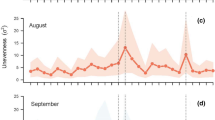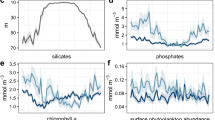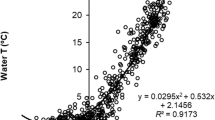Abstract
We determined the variation in the composition of plankton communities (zooplankton, phytoplankton, and ciliates) in subtropical lakes at different temporal scales, in relation to the seasons (dry and rainy seasons), as well as at finer (among months) and broader (ENSO—among El Niño, La Niña, and normal climate events) scales. Using a 16-year time-series dataset, we tested the hypothesis that seasonal variation would explain most of the gamma diversity of these plankton communities. We also investigated the environmental and temporal factors responsible for the variations in composition and species turnover. The scale related to dry and rainy seasons explained a considerable percentage of the gamma diversity and variation partitioning, showed that compositional changes occurred mainly over broader temporal scales. Environmental factors varying among seasons and ENSO events explained changes in composition, although some communities did not respond to the environment. Our results suggest that niche and stochastic processes operating at temporal scales correlated with ENSO climate events contributed to changes in species composition. Hence, climate anomalies might be important to maintain diversity in areas with reduced or loss of the natural variations in environmental conditions. Our results also suggest that, although communities show similar patterns of variation in composition, they might respond in a different degree to environmental and temporal factors. Thus, while niche-associated (environment) and stochastic (time) processes drove the phytoplankton, stochastic processes were more important for zooplankton, whereas neither were important for ciliates.






Similar content being viewed by others
References
Abrahams C (2008) Climate change and lakeshore conservation: a model and review of management techniques. Hydrobiologia 613:33–43. https://doi.org/10.1007/s10750-008-9470-5
Agostinho AA, Thomaz SM, Gomes LC (2004) Threats for biodiversity in the floodplain of the Upper Paraná River: effects of hydrological regulation by dams. Ecohydrol Hydrobiol 4:255–256
Agostinho AA, Thomaz SM, Gomes LC (2005) Conservation of the biodiversity of Brazil’s inland waters. Conserv Biol 19:646–652. https://doi.org/10.1111/j.1523-1739.2005.00701.x
Agostinho AA, Gomes LC, Pelicice FM (2007) Ecologia e manejo de recursos pesqueiros em reservatórios do Brasil. EDUEM, Maringá
Agostinho AA, Bonecker CC, Gomes LC (2009) Effects of water quantity on connectivity: the case of the upper Paraná River floodplain. Ecohydrol Hydrobiol 9:99–113. https://doi.org/10.2478/v10104-009-0040-x
Anderson MJ, Willis TJ (2003) Canonical analysis of principal coordinates: a useful method of constrained ordination for ecology. Ecology 84:511–525
Andersson MGI, Berga M, Lindström ES, Langenheder S (2014) The spatial structure of bacterial communities is influenced by historical envirionmental conditions. Ecology 95:1134–1140
Angeler DG, Johnson RK (2012) Patterns of temporal community turnover are spatially synchronous across boreal lakes. Freshw Biol 57:1782–1793. https://doi.org/10.1111/j.1365-2427.2012.02838.x
Angeler DG, Drakare S, Johnson RK (2011) Revealing the organization of complex adaptive systems through multivariate time series modeling. Ecol Soc. https://doi.org/10.5751/es-04175-160305
Anneville O, Souissi S, Ibanez F et al (2002) Temporal mapping of phytoplankton assemblages in Lake Geneva: annual and interannual changes in their patterns of succession. Limnol Oceanogr 47:1355–1366. https://doi.org/10.4319/lo.2002.47.5.1355
Attayde JL, Bozelli RL (1998) Assessing the indicator properties of zooplankton assemblages to disturbance gradients by canonical correspondence analysis. Can J Fish Aquat Sci 55:1789–1797. https://doi.org/10.1139/cjfas-55-8-1789
Baselga A (2010) Partitioning the turnover and nestedness components of beta diversity. Glob Ecol Biogeogr 19:134–143
Beck J, Holloway JD, Khen CV, Kitching IJ (2012) Diversity partitioning confirms the importance of beta components in tropical rainforest Lepidoptera. Am Nat 180:E64–E74. https://doi.org/10.1086/666982
Beisner BE, Peres-Neto PR, Lindström ES et al (2006) The role of environmental and spatial processes in structuring lake communities from bacteria to fish. Ecology 87:2985–2991. https://doi.org/10.1890/0012-9658(2006)87%5b2985:TROEAS%5d2.0.CO;2
Blanchet FG (2009) AEM: tools to construct asymmetric eigenvector maps (AEM) spatial variables. R Package Version 0.5-1/r118. http://R-Forge.R-project.org/projects/sedar/i
Blanchet FG, Legendre P, Borcard D (2008a) Modelling directional spatial processes in ecological data. Ecol Modell 215:325–336. https://doi.org/10.1016/j.ecolmodel.2008.04.001
Blanchet GF, Legendre P, Borcard D (2008b) Forward selection of explanatory variables. Ecology 89:2623–2632. https://doi.org/10.1890/07-0986.1
Borcard D, Gillet F, Legendre P (2011) Numerical Ecology with R. Springer, New York
Bortolini JC, Train S, Rodrigues LC (2016) Extreme hydrological periods: effects on phytoplankton variability and persistence in a subtropical floodplain. Hydrobiologia 763:223–236. https://doi.org/10.1007/s10750-015-2378-y
Bortolini JC, Pineda A, Rodrigues LC et al (2017) Environmental and spatial processes influencing phytoplankton biomass along a reservoirs-river-floodplain lakes gradient: a metacommunity approach. Freshw Biol 62:1756–1767. https://doi.org/10.1111/fwb.12986
Bottrell HH, Duncan A, Gliwicz ZM et al (1976) A review of some problems in zooplankton production studies. Norw J Zool 24:419–456
Bovo-Scomparin VM, Train S (2008) Long-term variability of the phytoplankton community in an isolated floodplain lake of the Ivinhema river state park, Brazil. Hydrobiologia 610:331–344. https://doi.org/10.1007/s10750-008-9448-3
Bozelli RL, Thomaz SM, Padial AA et al (2015) Floods decrease zooplankton beta diversity and environmental heterogeneity in an Amazonian floodplain system. Hydrobiologia 753:233–241. https://doi.org/10.1007/s10750-015-2209-1
Braghin LSM, Simões NR, Bonecker CC (2016) Hierarchical effects of local factors on zooplankton species diversity. Inland Waters 6:645–654. https://doi.org/10.5268/IW-6.4.919
Chao A, Chiu CH, Hsieh TC, Inouye BD (2012) Proposing a resolution to debates on diversity partitioning. Ecology 93:2037–2051. https://doi.org/10.1890/11-1817.1
Chaparro G, Horváth Z, O’Farrell I et al (2018) Plankton metacommunities in floodplain wetlands under contrasting hydrological conditions. Freshw Biol 63:380–391
Chase JM, Kraft NJB, Smith KG et al (2011) Using null models to disentangle variation in community dissimilarity from variation in α-diversity. Ecosphere 2:24. https://doi.org/10.1890/es10-00117.1
Cheng H, Sinha A, Cruz FW et al (2013) Climate change patterns in Amazonia and biodiversity. Nat Commun 4:1411. https://doi.org/10.1038/ncomms2415
Chesson PL, Warner RR (1981) Environmental variable promotes coexistence in lottery competitive systems. Am Nat 117:923–943
Cole AG (1994) Textbook of Limnology, 4th edn. Waveland Press, Inc., Prospect Heights
Coombes KR, Wang M (2018) PCDimension: finding the number of significant principal components. R package version 1.1.9
Crist TO, Veech JA (2006) Additive partitioning of rarefaction curves and species-area relationships: unifying α-, β- and γ-diversity with sample size and habitat area. Ecol Lett 9:923–932. https://doi.org/10.1111/j.1461-0248.2006.00941.x
Crist TO, Veech JA, Gering JC, Summerville KS (2003) Partitioning species diversity across landscapes and regions: a hierarchical analysis of alpha, beta, and gamma diversity. Am Nat 162:734–743. https://doi.org/10.1086/378901
De Bie T, De Meester L, Brendonck L et al (2012) Body size and dispersal mode as key traits determining metacommunity structure of aquatic organisms. Ecol Lett 15:740–747. https://doi.org/10.1111/j.1461-0248.2012.01794.x
De Boeck HJ, Bloor JMG, Kreyling J et al (2018) Patterns and drivers of biodiversity-stability relationships under climate extremes. J Ecol 106:890–902. https://doi.org/10.1111/1365-2745.12897
Deflandre G (1929) Le genre centropyxis Stein. Arch für Protistenkd 67:322–375
Dittrich J, Dias JD, Bonecker CC et al (2016) Importance of temporal variability at different spatial scales for diversity of floodplain aquatic communities. Freshw Biol 61:316–327. https://doi.org/10.1111/fwb.12705
Dolan JR (2005) An introduction to the biogeography of aquatic microbes. Aquat Microb Ecol 41:39–48. https://doi.org/10.3354/ame041039
Dornelas M (2010) Disturbance and change in biodiversity. Philos Trans R Soc Lond B Biol Sci 365:3719–3727
Elmoor-Loureiro MAL (1997) Manual de identificação de cladóceros límnicos do Brasi. Editora Universa, Brasília
Evans S, Martiny JBH, Allison SD (2017) Effects of dispersal and selection on stochastic assembly in microbial communities. ISME J 11:176–185. https://doi.org/10.1038/ismej.2016.96
Franklin JF (1989) Importance and justification of long-term studies in ecology. In: Likens GE (ed) long-term studies in ecology. Springer, New York, pp 3–19
Fukami T, Bezemer TM, Mortimer SR, Van Der Putten WH (2005) Species divergence and trait convergence in experimental plant community assembly. Ecol Lett 8:1283–1290. https://doi.org/10.1111/j.1461-0248.2005.00829.x
Gauthier-Lièvre L, Thomas R (1958) Le genre Difflugia, Pentagonia, Maghrebia et Hoogenraadia (Rhizopodes Testacès) en Afrique. Arch für Protistenkd 103:1–370
Gering JC, Crist TO, Veech JA (2003) Additive partitioning of species diversity across multiple spatial scales: implications for regional conservation of biodiversity. Conserv Biol 17(2):488–499
Gimmler A, Korn R, de Vargas C, Audic S, Stoeck T (2016) The Tara Oceans voyage reveals global diversity and distribution patterns of marine planktonic ciliates. Sci Rep https://doi.org/10.1038/srep33555
Gotelli NJ, Colwell RK (2001) Estimating species richness. In: Magurran AE (ed) Frontiers in measuring biodiversity. Oxford University Press, New York
Gotelli NJ, Shimadzu H, Dornelas M et al (2017) Community-level regulation of temporal trends in biodiversity. Sci Adv 3:e1700315
Grinnell J (1917) The niche-relationships of the California thrasher. Auk 34:427–433. https://doi.org/10.2307/4072271
Hallett LM, Hsu JS, Cleland EE et al (2014) Biotic mechanisms of community stability shift along a precipitation gradient. Ecology 95:1693–1700
Hastings A, Abbott KC, Cuddington K et al (2018) Transient phenomena in ecology. Science 361:eaat6412. https://doi.org/10.1126/science.aat6412
Heino J (2010) Are indicator groups and cross-taxon congruence useful for predicting biodiversity in aquatic ecosystems? Ecol Indic 10:112–117. https://doi.org/10.1016/j.ecolind.2009.04.013
Heino J, Melo AS, Bini LM (2015a) Reconceptualising the beta diversity-environmental heterogeneity relationship in running water systems. Freshw Biol 60:223–235. https://doi.org/10.1111/fwb.12502
Heino J, Melo AS, Siqueira T et al (2015b) Metacommunity organisation, spatial extent and dispersal in aquatic systems: patterns, processes and prospects. Freshw Biol 60:845–869. https://doi.org/10.1111/fwb.12533
Hessen DO, Faafeng BA, Smith VH et al (2006) Extrinsic and intrinsic controls of zooplankton diversity in lakes. Ecology 87:433–443. https://doi.org/10.1890/05-0352
Junk WJ, Bayley PB, Sparks RE (1989) The flood pulse concept in river-floodplain systems. In: Dodge DP (eds) In: Proceedings of the international large river symposium. Canadian Special Publication Fisheries and Aquatic Sciences, Otawa, 106:110–127
Kent AD, Yannarell AC, Rusak JA et al (2007) Synchrony in aquatic microbial community dynamics. ISME J 1:38–47. https://doi.org/10.1038/ismej.2007.6
Koste W (1978) Rotatoria die Rädertiere Mitteleuropas begründet von Max Voight. Monogononta. Gebrüder Borntraeger, Berlin
Küppers GC, Claps MC (2012) Spatiotemporal variations in abundance and biomass of planktonic ciliates related to environmental variables in a temporal pond, Argentina. Zool Stud 51:298–313
Lande R (1996) Statistics and partitioning of species diversity, and similarity among multiple communities. Oikos 76:5–13
Lansac-Tôha FM, Meira BR, Segovia BT et al (2016) Hydrological connectivity determining metacommunity structure of planktonic heterotrophic flagellates. Hydrobiologia 781:81–94. https://doi.org/10.1007/s10750-016-2824-5
Legendre P (2014) Interpreting the replacement and richness difference components of beta diversity. Global Ecol Biogeogr 23:1324–1334. https://doi.org/10.1111/geb.12207
Legendre P, Gallagher ED (2001) Ecologically meaningful transformations for ordination of species data. Oecologia 129(2):271–280
Legendre P, Gauthier O (2014) Statistical methods for temporal and space-time analysis of community composition data. Proc R Soc B Biol Sci 281:20132728. https://doi.org/10.1098/rspb.2013.2728
Leibold MA, Chase JM (2018a) Metacommunity patterns in space. In: Leibold MA, Chase JM (eds) Metacommunity ecology2. Princeton University Press, Princeton, pp 90–130
Leibold MA, Chase JM (2018b) Interactions between time and space in metacommunities. In: Leibold MA, Chase JM (eds) Metacommunity ecology. Princeton University Press, Princeton, pp 131–150
Lund JWG, Kipling C, Le Cren EDE (1958) The inverted microscope method of estimating algal numbers and the statistical basis of estimations by counting. Hydrobiologia 11:980–985. https://doi.org/10.1007/BF00007865
MacArthur R (1965) Patterns of species diversity. Biol Rev Camb Philos Soc 40:510–533
Madoni P (1984) Estimation of the size of freshwater ciliate populations by a sub-sampling technique. Hydrobiologia 111:201–206. https://doi.org/10.1007/BF00007200
Magurran AE, Deacon AE, Moyes F et al (2018) Divergent biodiversity change within ecosystems. Proc Natl Acad Sci. https://doi.org/10.1073/pnas.1712594115
Matsumura-Tundisi T (1986) Latitudinal distribution of Calanoida copepods in freshwater aquatic systems of Brazil. Braz J Biol 46:527–553
Medley KA, Havel JE (2007) Hydrology and local environmental factors influencing zooplankton communities in floodplain ponds. Wetlands 27:864–872
Neiff JJ (1990) Ideas para la interpretación ecológica del Paraná. Interciencia 15:424–441
Oksanen MJ, Blanchet FG, Kindt R et al (2012) vegan: Community Ecology Package. R package version 2.5-4
Padial AA, Ceschin F, Declerck SAJ et al (2014) Dispersal ability determines the role of environmental, spatial and temporal drivers of metacommunity structure. PLoS ONE 9:e111227. https://doi.org/10.1371/journal.pone.0111227
Paradis E, Claude J, Strimmer K (2004) APE: analyses of phylogenetics and evolution in R language. Bioinformatics 20:289–290. https://doi.org/10.1093/bioinformatics/btg412
Pecl GT, Araújo MB, Bell JD et al (2017) Biodiversity redistribution under climate change: impacts on ecosystems and human well-being. Science 355:eaai9214. https://doi.org/10.1126/science.aai9214
Peres-Neto PR, Legendre P, Dray S, Borcard D (2006) Variation partitioning of species data matrices: estimation and comparison of fractions. Ecology 87:2614–2625
Purves AW, Pacala SW (2005) Ecological drift in niche-structured communities: neutral pattern does not imply neutral processes. In: Burslem D, Pinard M, Hartley S (eds) Biotic interactions in the tropics: their role in the maintenance of species diversity. Cambridge University Press, New York, pp 107–140
R Development Core Team (2018) R: a language and environment for statistical computing. R Foundation for Statistical Computing, Vienna. https://www.R-project.org
Reid LW (1985) Chave de identificação e lista de referências bibliográficas para as espécies continentais sulamericanas de vida livre da ordem Cyclopoida (Crustacea, Copepoda). Bol Zool USP 9:17–143
Rodríguez-Ramos T, Dornelas M, Marañón E, Cermeño P (2014) Conventional sampling methods severely underestimate phytoplankton species richness. J Plankton Res 36(2):334–343
Segers H (1995) The Lecanidae (Monogononta). Guides to the identification of the Microinvertebrates of the Continental waters of the world 6. PB Academic Publishing, Kolkata
Segovia BT, Dias JD, Cabral AF et al (2017) Common and rare taxa of planktonic ciliates: influence of flood events and biogeographic patterns in Neotropical floodplains. Microb Ecol. https://doi.org/10.1007/s00248-017-0974-2
Simões NR, Lansac-Tôha FA, Velho LFM, Bonecker CC (2012) Intra and inter-annual structure of zooplankton communities in floodplain lakes: a long-term ecological research study. Rev Biol Trop 60:1819–1836
Simões NR, Dias JD, Leal CM et al (2013) Floods control the influence of environmental gradients on the diversity of zooplankton communities in a neotropical floodplain. Aquat Sci 75:607–617. https://doi.org/10.1007/s00027-013-0304-9
Smith TW, Lundholm JT (2010) Variation partitioning as a tool to distinguish between niche and neutral processes. Ecography (Cop) 33:648–655. https://doi.org/10.1111/j.1600-0587.2009.06105.x
Solari LC, Gabellone NA, Claps MC et al (2014) Phytoplankton chlorophyte structure as related to ENSO events in a saline lowland river (Salado River, Buenos Aires, Argentina). Ecol Evol 4:918–932. https://doi.org/10.1002/ece3.983
Souza Filho E (2009) Evaluation of the Upper Paraná River discharge controlled by reservoirs. Braz J Biol 69:707–716
Souza Filho EE, Stevaux JC (1997) Geologia e geomorfologia do complexo rio Baia, Corutuba, Ivinhema. In: Vazzoler AE, Agostinho AA, Hahn NS (eds) A Planície de inundação do alto rio Paraná: aspectos limnológicos e sócio-econômicos. EDUEM, Maringá, pp 3–43
Souza Filho EE, Rocha PC, Comunello E, Stevaux JC (2004) Effects of the Porto Primavera Dam on physical environment of the downstream floodplain. In: Thomaz SM, Agostinho A, Hanh NS (eds) The upper Paraná river and its floodplain: physical aspects, ecology and conservation. Backhuys Pubblishers, Leiden, pp 55–74
Stein A, Gerstner K, Kreft H (2014) Environmental heterogeneity as a universal driver of species richness across taxa, biomes and spatial scales. Ecol Lett 17:866–880. https://doi.org/10.1111/ele.12277
Steiner CF (2014) Stochastic sequential dispersal and nutrient enrichment drive beta diversity in space and time. Ecology 95:2603–2612
Su J, Tian T, Krasemann H et al (2015) Response patterns of phytoplankton growth to variations in resuspension in the German Bight revealed by daily MERIS data in 2003 and 2004. Oceanologia 57:328–341. https://doi.org/10.1016/j.oceano.2015.06.001
Sun J, Liu D (2003) Geometric models for calculating cell biovolume and surface area for phytoplankton. J Plankton Res 25:1331–1346. https://doi.org/10.1093/plankt/fbg096
Ter Braak C (1988) CANOCO—a Fortran program for canonical community ordination by [partial] [detrended][canonical] correspondence analysis, principal component analysis and redundancy analysis. (version 2.1), Report LWA-88-02. Agricultural Mathematics Group, Wageningen, Netherlands
They NH, Ferreira LMH, Marins LF, Abreu PC (2015) Bacterial community composition and physiological shifts associated with the El Niño Southern Oscillation (ENSO) in the Patos Lagoon Estuary. Microb Ecol 69:525–534. https://doi.org/10.1007/s00248-014-0511-5
Thomas MK, Fontana S, Reyes M et al (2018) The predictability of a lake phytoplankton community, over time-scales of hours to years. Ecol Lett 21:619–628
Tonkin JD, Altermatt F, Finn DS et al (2018) The role of dispersal in river network metacommunities: patterns, processes, and pathways. Freshw Biol 63:141–163. https://doi.org/10.1111/fwb.13037
Utermöhl H (1958) Zur Vervollkommnung der quantitativen Phytoplankton-Methodik. Mitteilungen der Int Vereinigung für Theor und Angew Limnol 9:1–38
Vasseur DA, Fox JW, Gonzalez A et al (2014) Synchronous dynamics of zooplankton competitors prevail in temperate lake ecosystems. Proc R Soc B Biol Sci 281:20140633. https://doi.org/10.1098/rspb.2014.0633
Xu H, Yong J, Xu G (2015) Sampling frequency of ciliated protozoan microfauna for seasonal distribution research in marine ecosystems. Mar Pollut Bull 101:653–659. https://doi.org/10.1016/j.marpolbul.2015.10.034
Zhang M, Chen F, Shi X et al (2018) Association between temporal and spatial beta diversity in phytoplankton. Ecography 41:1345–1356
Acknowledgments
We thank Dr. Luis M. Bini, Dr. Liliana Rodrigues, Dr. Roger Paulo Mormul, and Dr. Nadson R. Simões for valuable comments on the first version of this manuscript. We also acknowledge three anonymous referees for providing valuable suggestions that significantly improved the quality of the manuscript. We thank Nupélia and PELD (site 6)/CNPq for logistic and financial support. CAPES provided a scholarship to AP and CNPq provided Grants to OP. All authors have contributed substantially to this work.
Author information
Authors and Affiliations
Corresponding author
Ethics declarations
Conflict of interest
The authors declare that they have no conflict of interest.
Additional information
Publisher's Note
Springer Nature remains neutral with regard to jurisdictional claims in published maps and institutional affiliations.
Electronic supplementary material
Below is the link to the electronic supplementary material.
Rights and permissions
About this article
Cite this article
Pineda, A., Peláez, Ó., Dias, J.D. et al. The El Niño Southern Oscillation (ENSO) is the main source of variation for the gamma diversity of plankton communities in subtropical shallow lakes. Aquat Sci 81, 49 (2019). https://doi.org/10.1007/s00027-019-0646-z
Received:
Accepted:
Published:
DOI: https://doi.org/10.1007/s00027-019-0646-z




